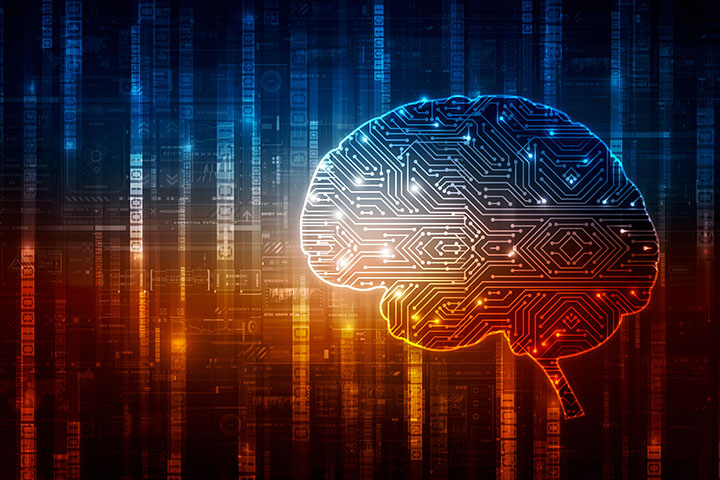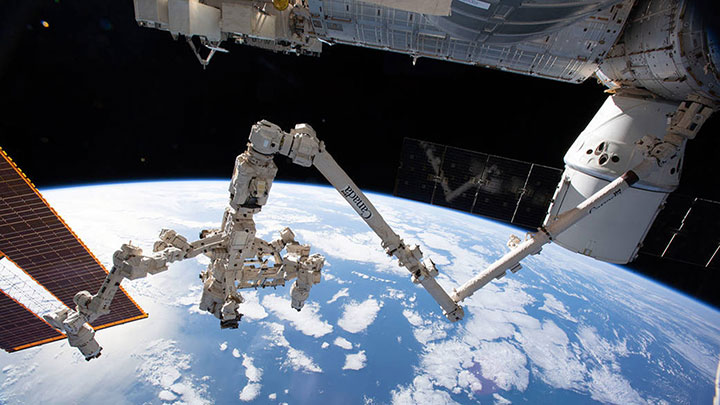By: S. Sita Sonty — August 8, 2023
If you’re anything like I am, you spent at least one weekend at the movie theatre this summer watching some blockbuster entertainment in the form of Barbenheimer or Mission Impossible: 7. Those of us in the space industry who, watching Tom Cruise’s latest film, may have stifled a chuckle over the moment (spoilers follow) when in an effort to counteract an experimental artificial intelligence (AI) program gone rogue, hacker extraordinaire Luther has to route through an old Russian spy satellite. His colleague Benji says, “Scraping the bottom of the barrel, but it will have to do.”

There is a fun irony that a Hollywood hacker leverages aging foreign spy satellite connectivity technology to hack into an American-made Large Language Model (LLM) AI supercomputer ominously dubbed The Entity. Nevertheless, the space industry continues to grapple with the opportunity of Generative AI (GenAI) as leaders and executives are answering in real-time. When it comes to capabilities in orbit, will GenAI defeat us or save us?
I believe that while AI has already powered so much of what we do in the space industry, GenAI will propel us even further into orbit. But to understand why, we need to piece apart how AI and GenAI applications are different, what GenAI can do that AI cannot, and describe use cases for GenAI that are already being developed. AI may have taken us to orbit, but GenAI will propel us to a new galaxy.
What is GenAI?
GenAI is not just hype, but a highly powerful series of capabilities with real traction for process automation and optimization. GenAI tools are able to create fully original text, images, audio and more, in mere moments. According to Google Cloud, Large Models (LMs) are the engines that power generative AI. Large Language Models (LLMs) are a common type of LM focused on text, but increasingly, cutting-edge LMs are multimodal, able to generate not only text from text prompts, but also images from text, images from images, and more. LMs typically include billions or even hundreds of billions of parameters, which refer to the size and complexity of the model.
At first blush, it would seem that building an LLM within a space company can be time-consuming, expensive, and complicated. Some organizations are investing in the capability to design LMs. When the scale is on the higher side, the compute costs skyrocket ($10 million to $30 million), not to mention additional associated costs for machine learning and human capital. As such, some space companies are looking to either acquire the AI/ML human capital (translation: skilled coding experts) to power the development of GenAI-based applications appropriate to their product lines or leverage third-party applications such as ChatGPT or others to deliver the rapid output.
In the case of in-sourced or vertically-integrated LM development, or outsourced third-party LM development, it makes sense to be skeptical. How do we know GenAI will drive value creation for the space economy? After all, GenAI is costly to create, challenging to execute, and the value proposition is still nascent.
Why GenAI for Space?
For GenAI to drive value creation in any industry, it needs to be easy to integrate, and it has to make business sense. Namely, existing processes must be able to generate parameters that GenAI can absorb and turn into an effective model. Moreover, in order to invest the time and resources to identify the parameters for a given GenAI solution and incorporate them into a space company’s process, the integration must solve a business problem from the outset –otherwise, the juice wouldn’t be worth the squeeze.
As mentioned before, GenAI is suited to perform tasks that generate output, such as text, audio, graphical media, design, code, data, and immersive experiences. However, those outputs must stem from large volumes of data as input for parameter generation. Those data sets must also have patterns that can be discerned by the model. And the business process relying on those data inputs must have clear optimization needs, driven by potentially creative solutions.
If space industry pioneers are thinking of developing GenAI applications, they must achieve these key goals:
- Increase program and process efficiency
- Reduce fixed costs
- Improve the experience of customers and/or the team
- Be easy to implement or integrate
- Protect intellectual property
- Prioritize cyber secure systems.
Many GenAI skeptics have expressed concern regarding the ethical use of AI. Given some public skepticism and regulatory scrutiny, businesses certainly must approach the design and usage of GenAI thoughtfully across the organization to mitigate the risk of unethical exposure of private or sensitive data.
Use Cases: What Should Space Do with GenAI?
As I argued in my op-ed “Automation a key enabler of the future space economy,” growth in the new space economy is increasingly dependent on automated systems to be self-sustaining, to generate minimal environmental impact, and to leverage decades of advances in automation at a multitude of orbits.
 The International Space Station’s Canadarm2 and robotic hand, Dextre, demonstrate the potential of automation and robotics in space. SpaceX Dragon cargo ship pictured in the upper right. (Source: NASA)
The International Space Station’s Canadarm2 and robotic hand, Dextre, demonstrate the potential of automation and robotics in space. SpaceX Dragon cargo ship pictured in the upper right. (Source: NASA)
In that piece, I argued that robotics and automation help reduce the cognitive burden on humans and outsource critical safety and system management responsibilities in dynamic space environments. I identified use cases for AI-driven automated process applications in commercial, civil, and national security contexts that deliver value for the space industry.
That was before the explosion of GenAI.
Which got me wondering … Which GenAI use cases are going to drive value creation for space? I spoke with a number of fellow space industry leaders from ThinkOrbital, Kayhan Space, Voyager Space, Google, and major OEMs. We developed the following series of use cases with powerful potential to impact the space economy—and make the investment worthwhile. Some of these use cases are already being implemented, showcasing how we in the space industry continue to lead the pack in innovation.
Use Case 1: Generative design (electronic, mechanic, etc.) at the component level
Companies could use generative AI to design components of new products faster and with fewer errors. In the space context, use cases including 3D printing of component-level materials, generating speed and reducing costs.
Use Case 2: Satellite imagery queries
Earth observation providers could use generative AI to illustrate relevant satellite data combined with geospatial data sets. For example, a GenAI-enabled chat interface could seek and request relevant satellite data in real-time with quicker response rates based on query inputs, which could further be enlisted for national security applications. In this case, the parameters are the geospatial data sets themselves. Satellite imagery could then be drawn from electro-optical satellite data. By adding the GenAI application, this could enable setting up a catalogue for geospatial data sets and potentially establishing resilient edge-to-cloud connectivity. This use case could enable more agility in imagery selection.
Use Case 3: Real-time operator support
GenAI could be leveraged to enable operators to document and report incidents while also providing real-time troubleshooting support. Existing use cases of GenAI outside the space context are capable of creating report incidents in the local language, translating and summarizing incidents and supporting with incident troubleshooting. Such an LLM could also be developed using datasets of incident reports for satellite or other spacecraft mission operations.
Use Case 4: Spacecraft on-ground root cause analysis and response support
GenAI could be leveraged to support spacecraft-to-ground operations in real-time to provide and communicate recommendations. The impact of such a use case would be to generate higher efficiency due to faster response time and less time grounding specific spacecraft. To illustrate the potential use case: when a fault code forces the grounding of a spacecraft, it is critical that there is a swift and coordinated response to minimize the spacecraft’s on-the-ground (SoG) time. Coping with SoG events requires back and forth interaction between operators and (satellite/other spacecraft) manufacturers to exchange data, engage relevant experts for root cause analysis, and test remediating solutions. GenAI can accelerate root cause analysis by recommending data and expertise required to close the case as well as no-regret actions based on previous cases.
Use Case 5: Certification documentation support
In this use case, GenAI could support certification processes by providing structure and content of certification documents.
Use Case 6: Testing scenario creation
The use of GenAI to create new and alternate scenarios—particularly those which require simulated environments—based on current testing mechanisms would clearly enrich existing portfolios of simulated/testing scenario creation, and make testing more resistant to possible failure modes.
Use Case 7: Cognitive automation
The use of GenAI transformer models could enable robots to perform previously “untrained” tasks based on generalization with no need for highly specific instructions (e.g., no coordinates). For example, a GenAI LLM could task a robot to maneuver an object in orbit based on general commands, which it would learn automatically and rapidly.
Use Case 8: Service technician guidance
The use of GenAI to support OEM field technicians in their day-to-day work by providing instant guidance and feedback in basic tasks could shorten execution timelines.
Use Case 9: Customer self-service/call center assistant
We all know the ChatBots from Amazon to Zillow; the use of GenAI driven to evaluate incoming requests, autonomously servicing where possible, and to support interactions with live agents, can shorten timelines for any space-based monitoring or tasks where direct interface with customer stakeholders is critical for ongoing program success.
Use Case 10: Virtual training facilitation
GenAI models allow rapid and hyper-personalized creation of training videos to engage employees; these could be leveraged and integrated to rapidly onboard new staff across the space value chain.
Use Case 11: Astronaut training simulations
GenAI training simulations, when applied to astronautics, could be tuned to specific skill levels, mission parameters, and novel situations.
Use Case 12: Generative design of spacecraft and space habitats
In this use case, GenAI models could be leveraged to most optimally balance weight, strength, reliability, and cost, elevated beyond the component level to the system level.
Use Case 13: Space traffic management and exploration path planning
In this use case, GenAI models could develop efficient routes for space hardware to move or maneuver in orbit, which would also maximize hardware safety.
Current Applications: What Are Industry Leaders Saying?
Kayhan Space has driven significant progress in the space traffic management domain, leveraging the very tools outlined in Use Case 13.
Per Kayhan Space CEO Dr. Siamak Hesar, “AI has become a bit of a buzzword these days in space, but there are certainly areas that can be helpful. In general, when it comes to simulation of space objects in space or estimating their states from observational data, we have well-characterized physics and dynamics models that explain the governing forces. So, AI will not be useful there despite many claims! However, AI can be useful in analyzing large trade spaces and finding pseudo optimal solutions to complex problems where analytical models could be too cumbersome to solve.”
 Kayhan Space is developing scenarios to apply GenAI to space traffic management. Kayhan is one of several space companies putting GenAI to practical use.
Kayhan Space is developing scenarios to apply GenAI to space traffic management. Kayhan is one of several space companies putting GenAI to practical use.
In fact, Kayhan is currently working on case studies for the practical application of GenAI.
These include:
- Optimization of large constellation scale maneuver plans given a complex set of constraints that result in non-convex or disjointed permissible space.
- Data association of uncorrelated tracks (UCTs) given large number of possibilities where analytical methods can suffer what’s called the curse of dimensionality.
- Anomaly and/or maneuver detection of non-cooperative objects at large catalogue scale.
Over at a major OEM, other use cases are being considered, such as:
- Satellite mission planning, i.e. payload resources management, especially for telecommunication payloads, both on single satellites and constellations. The GenAI applications would be useful on both a macro-planning level and on more specific algorithms embedded within planning processes.
- Next-generation simulators, i.e. GenAI could potentially support the creation of test cases, as the industry lacks enough information on measurements or real-life data.
- Earth observation processing with maybe two distinct paths: enhancement of the images, obfuscation of the images (for national security purposes).
Marshall Smith, CTO at Voyager Space, notes, “I see the potential for AI to change everything. We are working to get in on the ‘ground floor’ as it develops and matures. Some of our teams were beta testers on early AI systems and are fairly advanced in how to use it to our best advantage. Therefore, our designers are already using AI in the development process to speed more mundane activities along (document generation, etc.), which has been a significant help.”
ThinkOrbital CEO Sebastian Asprella outlined five processes that factor into ThinkOrbital’s current technology roadmap, designed to produce an in-orbit welding process for in-space manufacturing to service the burgeoning space economy by 2030.
- GenAI solutions can contribute to Autonomous Assembly; while a robotic arm might place a segment of an electron beam-steered welded product in place in a system which currently requires some human logistical coordination, full autonomy would be ultimately preferred whereby a robotic arm would correct itself if presented with an anomalous in-space manufacturing output.
- GenAI can provide powerful Predictive Analysis to inform how robotic arms should maneuver in space in response to an anticipated space debris collision, integrating the data from Space Situational Awareness databases being collected today using the primary parameters of two-line elements (TLEs) of resident space objects (RSOs), and auto-generating in-situ movement tasks.
- GenAI applications in the simulation and training environment are widespread, most directly for ThinkOrbital in simulating the outputs of the Solid Works Cut Design Tool yielding strength parameters which, when churned through a ChatGPT-like model, can identify points of failure as well respond to a given task of prescribed output.
- GenAI tools can create optimized processes for mission resource management by reducing the risk of error from human command/control, leveraging database parameters of real mission task performance against optimal mission task performance metrics.
- Finally, GenAI can be leveraged to ultimately manage the autonomous orbital infrastructure of the future, prescribing rules of movement and engagement in response to national security threats on an automated basis when time would be a critical basis for warfighting advantage.
GenAI X Space: A Fine Pairing
The space industry seems like a natural ecosystem to harness the full power of value creation driven by GenAI solutions. After all, few industries have demonstrated the ability to develop new technology with such innovative rigor. The space industry also will drive market gains for companies continuing to optimize processes of production, supply chain, and integration.
As space companies set aside investment and research and development (R&D) funding in annual technology roadmapping exercises, they would be wise to identify the prioritized use cases for their product lines where GenAI applications could create value, and double down on their value creation now to secure the benefit over the next five years.
Perhaps some months down the line, a GenAI tool could write this op-ed on its own, identifying additional use case applications in real-time and extolling their virtues for the space industry to absorb. Until then, this perspective will have to do.
About the Author
S. Sita Sonty is currently on sabbatical. She held roles as Commercial Space Lead for Boston Consulting Group, Head of Human Spaceflight Sales at SpaceX, Vice President for Strategy at Sierra Nevada, and served as a career diplomat in the United States Foreign Service.
Explore More:
A Diplomatic and More Economic Space: 2023 Outlook with Sita Sonty
Podcast: Future of Satellite Connectivity, New Satellite Applications and Key 2023 Space Trends
BCG Space Executive Explains Growth Trends for Value-Added Space Services
